Exploring Downtown Dubai's Iconic Architectural Wonders
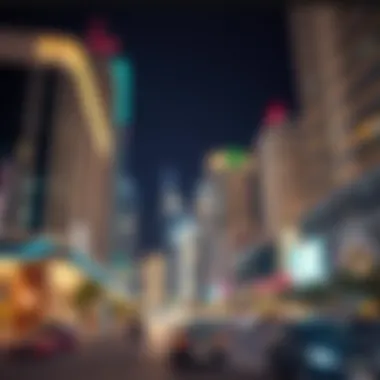
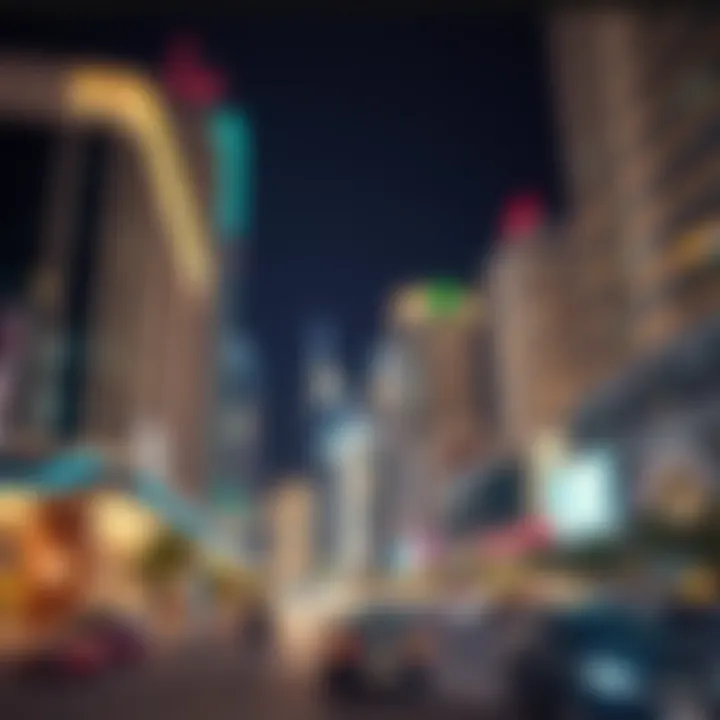
Market Trends
As Downtown Dubai continues to capture the attention of investors, understanding the current market trends becomes imperative for potential buyers and stakeholders. This vibrant area is witnessing an evolution marked by significant property development, infrastructural advancements, and a steady increase in property values.
Current Property Prices
In recent years, property prices in Downtown Dubai have exhibited a burgeoning upward trend. For instance, luxury apartments in buildings adjacent to the Burj Khalifa average around AED 3.5 million, while those in high-demand areas tend to be even more expensive. This significant price point reflects not only the prestige of living in a globally recognized architectural hub but also the robust investment potential present in the region. Investors should remain cautious, however, as fluctuations may arise due to varying demand and economic conditions.
Emerging Areas for Investment
A keen eye on emerging areas within the Downtown Dubai precinct can reveal lucrative opportunities. Places such as Dubai Creek Harbour and Dubai Design District are rapidly developing, and they are increasingly becoming attractive for investors seeking to capitalize on anticipated growth. The government’s ongoing initiatives and investments in infrastructure boost these neighborhoods' appeal, paired with their proximity to Downtown’s iconic landmarks.
Living in Dubai
Living in Downtown Dubai is more than just a housing choice; it's an experience shaped by cosmopolitan culture and a range of amenities that cater to diverse lifestyles.
Cultural Insights for Expats
Navigating the cultural landscape as an expatriate in Dubai can be both exhilarating and challenging. The city's melting pot environment, rife with vibrant multicultural influences, introduces new traditions and perspectives into daily life. Understanding local customs, such as hospitality norms and religious practices, is key for harmony and mutual respect among diverse communities.
Amenities and Lifestyle Features
The amenities available in Downtown Dubai are second to none. From high-end retail outlets in the Dubai Mall, which houses over 1,200 shops, to the iconic fountain shows outside, residents and visitors alike bask in luxury. The culinary scene is another highlight, featuring a medley of international dining options ranging from street food to Michelin-starred establishments. Additionally, residents benefit from well-maintained parks and recreational areas, providing a balance between urban living and leisure.
"Downtown Dubai isn't just about skyscrapers; it's about a lifestyle that blends modernity with cultural resonance and tradition." - Local Urban Development Expert
As one delves deeper into the architectural landscape of Downtown Dubai, they will discover not just buildings, but the story of a city constantly reinventing itself. The synergy between economic growth, cultural integration, and cutting-edge design makes this area not only appealing but essential for future investment."
For more insights, visit Wikipedia or check discussions on Reddit for the latest trends and experiences shared by locals.
Intro to Downtown Dubai
Downtown Dubai stands as a hallmark of modern engineering and design, intertwining cultural sentiment with cutting-edge architecture. This area, often referred to as the very heart of Dubai, epitomizes what the city represents in the global landscape – a dazzling amalgamation of luxury, innovation, and dynamic living.
A stroll through Downtown reveals a tapestry of colossal structures that don't just scrape the sky but also redefine the boundaries of what’s architecturally possible. Investors and homebuyers alike will find that this area is not merely about its iconic skyline; it's about the vibrancy of community and the promise of prosperity.
Importance of Downtown Dubai
The significance of Downtown Dubai transcends its aesthetic appeal. Here, impressive structures serve practical purposes, functioning as business hubs, leisure spaces, and cultural centers. The beguiling skyline is anchored by the Burj Khalifa, the tallest building in the world, embodying human ambition and ingenuity.
For potential investors, the real estate market in Downtown Dubai holds immense potential. Property here is often seen as a strong investment due to increasing demand fueled by tourism and the influx of expatriates seeking a dynamic urban life. The blend of high-end apartments, commercial spaces, and leisure facilities makes it a versatile investment opportunity.
Furthermore, the area thrives as a social and cultural nucleus. The Dubai Mall and its surrounding arena offer more than shopping; they provide a mosaic of human interactions, drawing millions of visitors annually. In 2022, the mall drew roughly 14 million visitors, showcasing its influence on tourism and local economy.
As the city progresses, the architectural landscape of Downtown Dubai will continue to evolve, presenting new challenges and opportunities. For those looking to stake a claim in this vibrant community, understanding the environment and urban dynamics is crucial.
In summary, Downtown Dubai is not just a geographical location; it is a potent symbol of aspiration and modern living, where towering structures inspire a sense of awe and promise an imaginative vision of what urban life can be. For anyone looking to invest, reside, or simply explore, acknowledging the importance of this area is paramount. It's about more than concrete and glass; it's about a lifestyle that embraces the future without losing touch with its roots.
The Architectural Significance
The architectural significance of Downtown Dubai extends far beyond mere aesthetics; it's a testament to innovation, cultural identity, and economic vitality. This landscape is not just about designing tall buildings; it reflects the city’s aspirations on a global stage. In a world where urban spaces frequently become indistinguishable, Downtown Dubai stands as a beacon of distinctive architecture that combines cutting-edge design with functional purpose.
Unique Elements and Cultural Reflection
Each building tells a story. Take the Burj Khalifa, for instance, which symbolizes the core values of ambition and progress that embody Dubai itself. Designed by Adrian Smith of Skidmore, Owings & Merrill, its height and intricate design echo the region's historical architecture while pushing new boundaries in engineering.
Similarly, the Dubai Mall integrates shopping with leisure activities, making cultural consumption a central part of its user experience. These structures illustrate how architecture can become a canvas reflecting the culture and economic vitality of a place.
Benefits of Architectural Innovations
Innovations in the architectural design of Downtown Dubai also serve numerous practical benefits. For property investors and insituitons, the mix of private and public spaces results in increased foot traffic, enhancing real estate value. Moreover, the iconic buildings attract significant tourism, contributing to the city's economy. This dual effect of attracting both residents and visitors intertwines the economic fabric of Downtown Dubai with its architectural choices.
Considerations for Future Development
As the area continues to develop, understanding the significance of its architectural landscape becomes crucial for potential investors and developers. Each new project must consider the aesthetic and functional standards established by existing structures while also aligning with sustainable practices. The future of Downtown Dubai's architecture will likely push the envelope further, with eco-friendly designs and smart technology integrated into new projects, allowing them to harmonize within the city's unique architectural fabric.
"The beauty of a city lies in its buildings, but its soul is shaped by the lives they foster."
Understanding this significance is key for stakeholders involved in shaping the future of this remarkable urban landscape.
Innovative Design Approaches
Innovative design approaches within Downtown Dubai's architectural realm are breaking molds and setting new standards.
Environmental Considerations
The integration of green building technologies is becoming prominent. For example, places like the Museum of the Future showcase a marriage of stunning visuals with sustainable systems, drawing visitors and setting a precedent for future projects. The fluidity of form in structures, like the twisted silhouette of the Address Downtown, reflects a deep understanding of both aesthetics and functionality.
Adaptive Reuse and Urban Revitalization
Additionally, adaptive reuse projects are gaining traction as they breathe new life into historical elements of the city. This includes not just preserving the past but reinvigorating local communities, thus balancing modern needs with historical context. Consider the Dubai Design District, where art and commerce intertwine, showcasing local artistry while attracting global attention.
Iconic Structures and Their Designers
Prominent structures in Downtown Dubai aren't mere buildings; they represent the culmination of aesthetic vision, engineering prowess, and cultural context.
A Global Influence
The Burj Khalifa remains the crown jewel, designed by Adrian Smith, while the Dubai Mall, conceptualized by the Emaar Properties developers, offers an unparalleled shopping experience. Each is an architectural narrative in its own right, contributing to a greater dialogue about urban planning, development, and cultural exchange.
Diverse Signatures
Other notable designs include the futuristic Museum of the Future, shaped by Killa Design, emphasizing the role of technology in society. These buildings not only capture the spirit of the present but also ponder on the ultimate questions for humanity’s future.
This blend of talent and vision creates a cohesive architectural dialogue that defines the essence of Downtown Dubai.
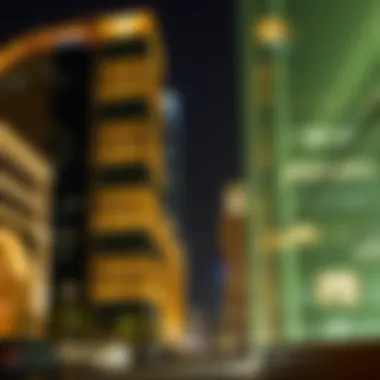
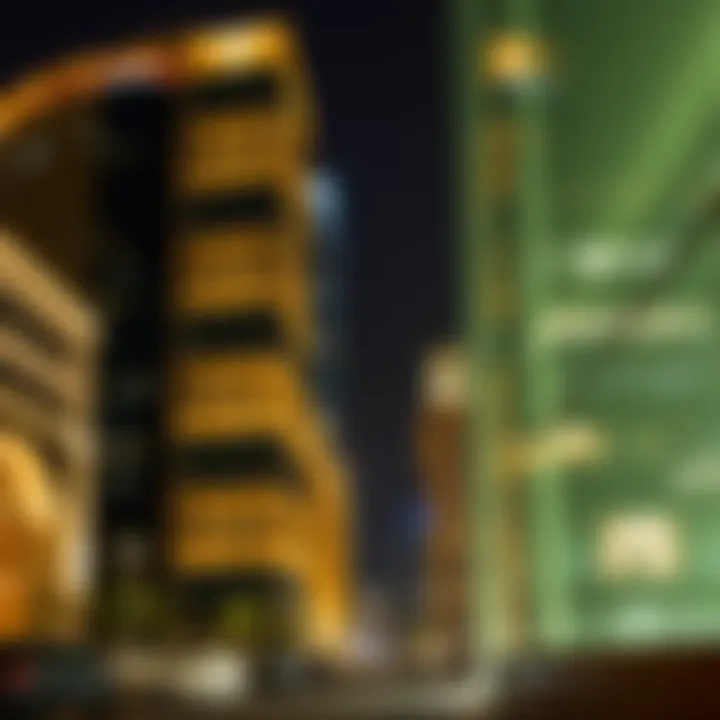
Key Structures of Downtown Dubai
The architectural landscape of Downtown Dubai can be defined by its key structures, each standing as a testament to human creativity and engineering prowess. These buildings are not just concrete and steel; they embody the ambitions and aspirations of a rapidly developing city. By examining these structures, one gains insight into not just the architectural significance but also the economic and cultural influences these icons hold.
The Burj Khalifa
Structural Features
The Burj Khalifa is not merely a tall building; it is an architectural feat that pushes the boundaries of engineering. With its unique triple-lobed footprint, the design is inspired by Islamic architecture, aiming for both beauty and functionality. This structure incorporates a central core, which provides enhanced lateral stability, allowing it to withstand the strong winds common in the region. The use of advanced materials, like high-strength concrete, has made it possible for the Burj Khalifa to reach new heights while ensuring safety and sustainability.
One significant characteristic of its structural features is the incorporation of an innovative mixed-use area that combines residential, commercial, and leisure spaces. This not only enhances the building’s utility but also its popularity among potential residents and investors.
Height and Scale
Reaching an astonishing height of 828 meters, the Burj Khalifa is the tallest building in the world, serving as a symbol of Dubai's ambition. Its height not only offers breathtaking views but also provides a sense of pride to the city. The scale of the building allows for a mix of uses—residential, office, and leisure—which has solidified its status as a social and commercial hub.
However, the height presents unique challenges, such as the complexity of construction and maintenance, which requires exceptional planning and execution. The building’s sheer size significantly contributes to the skyline, making it a dominant feature and drawing countless tourists.
Cultural Impact
Culturally, the Burj Khalifa plays an important role as it represents innovation and ambition. It has become a global icon, recognized far beyond the boundaries of Dubai. As such, it serves as a backdrop for numerous cultural events, from fireworks displays to light shows that gather locals and tourists alike.
The connection it fosters among diverse communities contributes to a shared identity that resonates with residents and visitors. Its design is not just for aesthetic appeal but has a narrative that echoes the traditions and modernity of Dubai. This amalgamation of cultures is vital in shaping the city’s international perception.
Dubai Mall
Retail Experience
The Dubai Mall is an extraordinary shopping complex that transcends typical retail spaces. It caters to every taste, featuring over 1,200 shops, including high-end designer brands and quirky boutiques, creating a vibrant consumer experience. This diverse retail landscape contributes significantly to the economy, drawing in millions of visitors annually.
A highlight of the retail experience is its ability to engage shoppers beyond mere transactions—it offers an atmosphere that combines luxury, comfort, and comprehensive services. Such a multifaceted shopping approach enhances customer satisfaction, while also driving footfall to surrounding areas.
Aquarium and Entertainment
Central to the Dubai Mall is its colossal aquarium, the Dubai Aquarium and Underwater Zoo, which serves as a captivating attraction for all ages. It's one of the largest suspended aquariums in the world, featuring a myriad of aquatic species. The integration of entertainment with retail isn't just an afterthought but a cornerstone of the mall's appeal. It keeps families and tourists engaged, encouraging longer visits and repeat trips.
The aquarium, through its educational programs and thrilling experiences, like shark dives, raises awareness about marine life conservation. This multifarious aspect enhances the mall's global status as a leading shopping and entertainment destination.
Architectural Highlights
Architecturally, the Dubai Mall is as striking as its offerings. The sleek, modern design pairs with the surrounding buildings, creating a harmonious urban environment. Its impressive glass façade allows natural light to pour in, contributing to an inviting ambiance.
A unique architectural feature of major note is the mall's iconic central atrium, which often hosts art installations and cultural exhibitions. While providing sensational showpieces, these elements also serve to elevate the cultural awareness and interest of visitors. Thus, the architectural highlights of the mall reinforce its position as a cultural hub in addition to being a commercial powerhouse.
Dubai Fountain
Engineering Marvel
The Dubai Fountain is a remarkable engineering achievement, synchronizing water, music, and light in a choreographed show that mesmerizes spectators. Spanning over 275 meters, it is one of the largest fountains in the world, with capable jets that shoot water up to 150 meters high. This extraordinary spectacle not only enhances the aesthetic appeal of the Burj Khalifa's surroundings but also showcases complex engineering techniques.
One of the standout elements is the innovative underwater system that coordinates the fountain’s movements in perfect time with accompanying music, making each performance a unique experience. This marriage of art and science adds a delightful layer to the financial and cultural fabric of Dubai.
Performance Features
Performance is key to the success of the Dubai Fountain. With shows happening every half hour, visitors are continuously captivated by its intricate choreography. The blending of various musical scores from around the world enhances the allure, attracting visitors from different backgrounds, which is essential for tourism and cultural exchange.
The fountain’s ability to integrate visual and auditory stimulation is a beneficial choice for promoting the region's cultural offerings. However, it also means that ongoing maintenance must be a top priority to ensure it remains a source of pride.
Visitor Experience
The visitor experience at the Dubai Fountain is marked by a combination of accessibility and breathtaking visuals. Strategically located around the Burj Khalifa Lake, it offers viewing spots that allow guests to capture the spectacle on their devices while enjoying scenic walks.
In offering a unique blend of nature and architecture, it prompts visitors to linger, explore, and interact with their surroundings. This interaction not only heightens the engagement but solidifies Downtown Dubai as a premier tourism destination, promoting economic vitality in the area.
"In summary, the key structures of Downtown Dubai aren't just landmarks; they're an integrated tapestry of the city's ambition, culture, and economy."
These features articulate how essential these structures are to the identity of Downtown Dubai, intertwining modern architecture with cultural significance and economic contributions.
Economic Impact of Downtown Developments
The economic landscape of Downtown Dubai cannot be understated. The real estate, tourism, and hospitality sectors stand at the forefront of this thriving urban environment. These developments do not only reshape the skyline but also play a crucial role in enhancing the economic vitality of the region. The ongoing evolution reflects the ambitious vision of Dubai, transforming it into a global hub for business and innovation.
Real Estate Values
Trends in Property Prices
Property prices have seen a dynamic shift over recent years, influenced by a cocktail of market forces and global events. The pulse of the market has been vibrant, largely due to the emergence of new architectural landmarks. High levels of demand in Downtown Dubai have driven prices upwards, but this is not merely a phenomenon of speculative investment. There’s a strong demand for luxury living spaces, fostered by the influx of expatriates and high-net-worth individuals seeking both residential and investment opportunities. Prices in specific areas, such as those near the Burj Khalifa, tend to reflect a premium, commanding significant investment.
Key characteristics of these trends include:
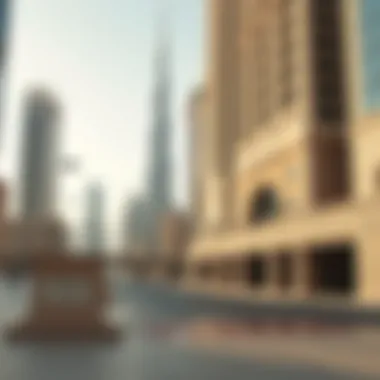
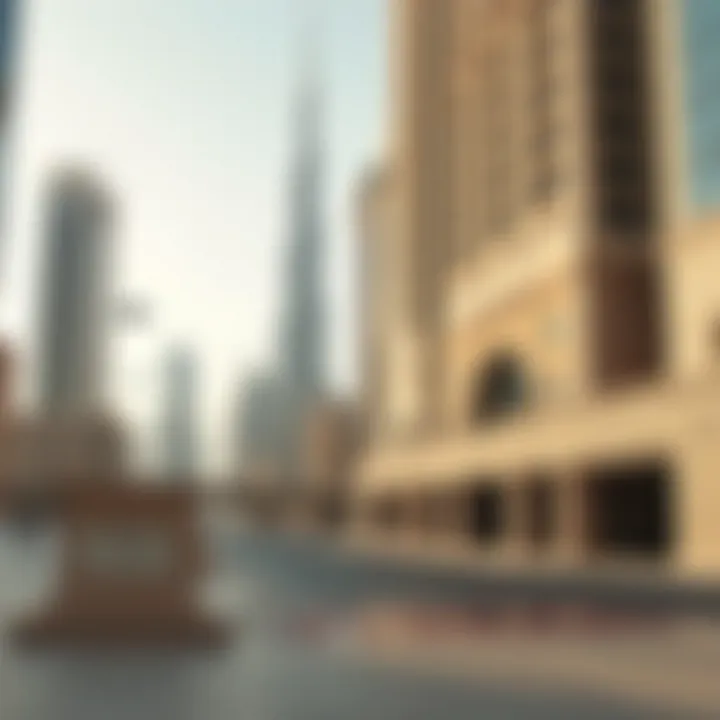
- Location desirability: Proximity to iconic structures elevates property values.
- Market resilience: Despite global slowdowns, Downtown Dubai has maintained stability due to its economic framework.
- Future projects: Ongoing developments suggest continued upward pressure on prices.
However, it is not all rosy; fluctuations based on external factors can pose risks. Investors should tread carefully, keeping an eye on macroeconomic indicators.
Investment Opportunities
Investing in Downtown Dubai emerges as a lucrative option for many. The market offers diverse avenues, from residential apartments to commercial spaces, tailored to various investor profiles. With attractions like the Dubai Mall and cultural institutions, the foot traffic is a goldmine for businesses. Furthermore, the strategic governmental policies favoring foreign investment make it a hotbed for enticing opportunities.
Unique features of these investment opportunities include:
- Proven ROI: Historical data suggests a healthy return on investment, encouraging further exploration.
- Tax advantages: Many investors find solace in the relatively low tax regime prevalent in the UAE.
- Growth potential: Projects like the Museum of the Future are poised to uplift property values in surrounding areas.
Yet, potential investors should remain aware of market saturation and personal financial objectives before diving in.
Tourism and Hospitality
Visitor Statistics
Dubai’s position as a leading tourism destination contributes immensely to its economic landscape. Last year, Downtown Dubai recorded millions of visitors, showcasing its allure. This steady influx of tourists from all corners of the globe impacts everything from retail to service industries within the area. The rich cultural offerings and entertainment options make it a bustling hub.
Notable aspects of visitor statistics include:
- Diverse demographic: Visitors range from leisure tourists to business travelers, expanding the market reach.
- Increased duration of stay: Many enjoy extended visits, benefiting local businesses.
However, one must note that fluctuations in global economies or external shocks such as pandemics can impact these figures significantly. It’s pivotal for businesses to adapt swiftly to changing circumstances.
Hotel Developments
The hospitality sector in Downtown Dubai exhibits incessant growth as new hotels and resorts pop up regularly. Renowned names such as the Armani Hotel and the Address Hotels boost the area's prestige, giving visitors luxury experiences. The blend of opulent stays and strategic locations ensures a constant rotation of guests.
Characteristics of hotel developments include:
- Innovative designs: Hotels often reflect the avant-garde architecture that defines the area.
- Sustainability efforts: Many establishments incorporate eco-friendly practices, appealing to conscientious travelers.
- Unique offerings: From themed experiences to wellness programs, hotels cater to diverse preferences.
While these developments typically attract visitors, the challenge lies within market competition. As more options arise, maintaining high service standards and unique offerings becomes essential for survival.
Cultural Relevance of Buildings
In Downtown Dubai, the architectural landscape is not just a collection of impressive buildings but also a tapestry rich with cultural significance. Buildings serve as more than mere structures; they reflect the identity and heritage of a city. In this vibrant urban environment, each edifice tells a story that contributes to the communal narrative.
Cultural Institutions
The Museum of the Future
The Museum of the Future stands out as a futuristic beacon, designed to challenge our perceptions of what museums can be. Its unique shape, resembling a torus, captivates visitors even before they step inside. This museum goes beyond traditional exhibits by focusing on innovative technologies and future societal concepts.
One of the key characteristics that makes the Museum of the Future appealing is its commitment to interactive displays. The museum leverages cutting-edge technologies to engage its visitors in ways that are both educational and entertaining. This immersive experience allows the public to explore concepts such as artificial intelligence, sustainability, and space exploration in a way that is rarely achieved in standard museums.
The advantages of such an establishment are clear: it attracts not just tourists but also locals, becoming a space for learning and dialogue. However, it does face challenges, like the necessity to stay ahead of rapid technological changes. As trends evolve, maintaining relevance requires continuous reinvention, which can pose financial and creative strains.
Art Installations and Exhibits
Art installations and exhibits around Downtown Dubai enrich the cultural fabric of the city, offering a vibrant visual experience that changes often. These installations often tackle pressing social themes and invite discourse among residents and visitors alike.
The art scene benefits significantly from public engagement, which is a hallmark of the various art pieces scattered across the area. Noteworthy is how these installations often integrate local artists, showcasing indigenous talent alongside international works. This fusion creates a dialogue that is both locally rooted and globally relevant.
However, one might argue that the ephemeral nature of these exhibits can be a disadvantage, as they do not maintain a permanent presence. Visitors may find that their favorite piece may vanish in mere months, creating a sense of urgency to experience art while it lasts.
Public Spaces and Community Life
Parks and Recreation
Public parks are gems in Downtown Dubai, providing much-needed green spaces amid the bustling urban landscape. They serve as oases where families gather, joggers stretch their legs, and friends meet for a casual chat. Parks support physical well-being and enhance community connectivity.
Not only are these parks aesthetically pleasing, but they also promote sustainability. Engaging in environmental preservation efforts, many parks showcase flora native to the region. The challenge lies in ensuring that these green spaces are maintained effectively amid rapid urban growth, ensuring they remain inviting for all.
Social Gatherings
Social gatherings in public spaces form the heartbeat of the community, allowing for the mixing of different cultures and backgrounds. Events held in places like the Dubai Fountain or The Dubai Mall courtyard are focal points where people engage in celebrations, festivals, and casual meet-ups. These gatherings foster a sense of belonging and create lasting friendships.
One unique aspect of such social events is their inclusivity, being open to all walks of life. However, the downside can be moments of overcrowding, which occasionally diminishes the enjoyment of the experiences.
In summary, the cultural relevance of buildings in Downtown Dubai cannot be overstated. They serve various roles, from becoming significant social landmarks to embodying educational opportunities, enriching the lives of both residents and visitors.
Sustainability Initiatives
Downtown Dubai stands as a testament to modern architectural brilliance, but what really sets it apart in today's climate-conscious world is its commitment to sustainability initiatives. With expansion on a global scale often comes significant environmental implications, and addressing these is essential for the future integrity of urban landscapes. Therefore, sustainability initiatives not only enhance the livability of such cities but also ensure their resilience against environmental challenges.
Sustainability in architecture goes beyond mere aesthetics. It involves a comprehensive approach that melds environmental responsibility with innovative design. In Downtown Dubai, this manifests in various ways, from energy-efficient structures to waste reduction strategies. Implementing these practices ensures not only ecological benefits but also boosts economic performance, making the city a model for future urban development.
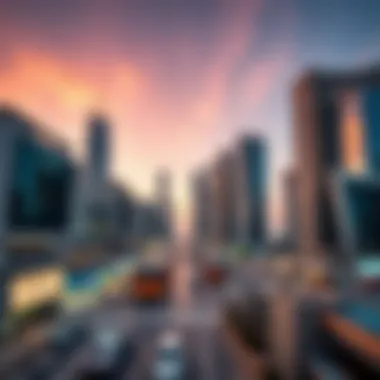
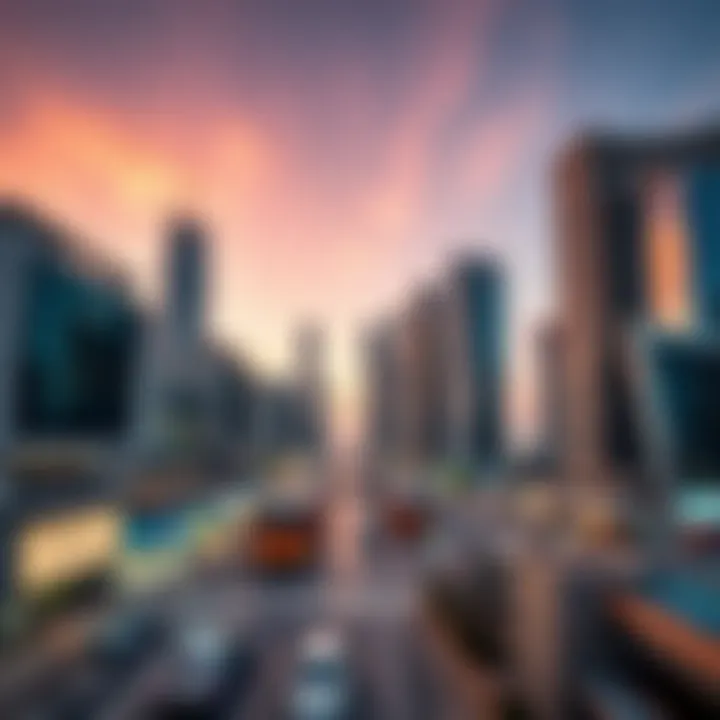
Green Building Standards
The concept of green building standards is pivotal to the construction ethos in Downtown Dubai. These standards typically encompass a range of practices aimed at minimizing a building’s environmental impact. In simple terms, they focus on things like energy efficiency, water saving, and materials selection. The Dubai Green Building Regulations, for instance, have set benchmarks that buildings must meet to be classified as environmentally friendly.
Consider the Burj Khalifa, for example; it utilizes advanced insulation materials to minimize heat gain, aided by energy-efficient lighting systems. Such features not only reduce energy consumption but also decrease costs for occupants, presenting a clear advantage for investors and businesses operating within these spaces.
- Energy Efficiency: Smart systems are installed in buildings to optimize heating, cooling, and lighting.
- Water Conservation: Advanced technologies capture and recycle wastewater, which significantly reduces consumption.
- Sustainable Materials: The use of locally sourced and recycled materials lessens the carbon footprint of construction practices.
These green building standards reflect a growing awareness and responsibility towards creating urban environments that harmonize with nature.
Future Developments and Sustainability
Looking ahead, future developments in Downtown Dubai are poised to further embrace sustainability as a core tenet of urban evolution. Developers are increasingly integrating sustainable practices right from the design stage, considering environmental implications long before construction begins.
"Sustainable architecture is not just a trend; it is the future of urban living in a climate-conscious world."
For instance, projects like Dubai Creek Tower are focusing on energy recovery systems and smart grids to ensure they adapt to the needs of future generations. With electric vehicle charging stations and extensive green spaces, it highlights that urban living doesn’t have to come at the expense of nature.
Challenges and Concerns
When discussing the architectural grandeur of Downtown Dubai, it is crucial to shed light on the challenges and concerns that accompany such ambitious developments. These issues can impact not just the architectural landscape, but also the economic and social fabric of the area. Understanding them gives investors, homebuyers, expatriates, brokers, and developers a clearer picture of the dynamics at play.
Urban Overdevelopment Issues
As the skyline of Downtown Dubai continues to reach new heights, the concerns regarding urban overdevelopment rise correspondingly. The frenzy of towering skyscrapers and luxurious malls can sometimes lead to a haphazard urban sprawl that lacks coherence and planning. Various stakeholders, including city planners and community members, have voiced their worries about whether this rapid growth can be sustained in the long run.
One of the pressing challenges is the pressure on infrastructure. With an increase in residents and tourists, the existing transportation networks may become inadequate. Roads may not be able to cope, leading to congestion and reduced quality of life. Additionally, public services like waste management, water supply, and power may also face enormous strain. A lack of foresight in developing these basic amenities could cause residents and investors to reconsider their commitment to the area.
Furthermore, density often affects the atmosphere and ambiance that attracted many to Dubai in the first place. The once open spaces may be replaced by congested areas where it's hard to find a calm moment. This paradox can deter potential buyers who seek both the vitality of urban life and the tranquility of well-designed public spaces.
- Impact on Lifestyle: As urban areas become denser, lifestyle changes often follow. A bustling schedule may shift from leisurely strolls to hurried commutes.
- Environmental Effects: More buildings can lead to higher temperatures, impacting air quality and overall livability.
- Community Identity: The essence of community often gets diluted when buildings overshadow human interactions, leading to a more isolating experience for residents.
Maintenance and Preservation Challenges
Even amidst towering modern edifices, the challenge of maintenance and preservation cannot be overlooked. The style and complexity of many buildings require continuing investment to maintain their original luster. An example is the Burj Khalifa, which, while being a marvel of engineering, demands ongoing care to ensure that its glass façade remains pristine. The costs associated with such maintenance can often surprise developers and investors who initially seek high returns from their properties.
Moreover, the distinction between preserving architectural integrity and making updates to keep pace with modern needs can become contentious. Maintaining the buildings often entails balancing between keeping the aesthetics intact, which drew people in, and adapting to the latest technological innovations to ensure sustainability.
Some key points under this topic include:
- Restoration Costs: Maintaining the fabric of these iconic structures can lead to significant expenses.
- Technology Integration: While new technologies can enhance functionality, they can also clash with original designs.
- Regulatory Standards: Keeping pace with changing building codes and regulations adds another layer of complexity for maintainers and owners alike.
Ultimately, successful maintenance and preservation hinge on strategic planning and adequate funding. Without proper foresight, magnificent structures could become neglected relics of a bygone era.
In summary, while the architectural evolution of Downtown Dubai exudes ambition and promise, understanding the challenges of urban overdevelopment and maintenance is vital. They constitute two sides of the same coin, where careful management can pave the way for a vibrant and sustainable architectural landscape.
Future Prospects for Downtown Dubai
Future prospects for Downtown Dubai are not just a crystal ball gazing exercise; they reflect substantial shifts in urban planning, investment strategies, and lifestyle aspirations. As this dynamic city embraces a wave of technological advancements and sustainable development, understanding what lies ahead is critical for investors, homebuyers, expatriates, and developers alike. In the years to come, the architectural fabric of Downtown Dubai will continue to evolve, blending the region's rich cultural heritage with cutting-edge innovations.
Emerging Projects
In Downtown Dubai, a host of emerging projects promises to redefine the skyline and offer new opportunities.
- Dubai Creek Tower: Set to surpass the Burj Khalifa, the Dubai Creek Tower is designed to symbolize the region's growth and aspirations. Slated for completion soon, it aims to become a prime attraction, merging tourism with cutting-edge residential spaces.
- Dubai Square: This upcoming retail and lifestyle destination is projected to be a game changer for shopping and entertainment in the region. It aims to attract international brands and upscale retail experiences, fostering a vibrant atmosphere.
- The Museum of the Future: While already operational, expansions around this innovative museum are underway, incorporating more interactive and engaging experiences that will attract tourists and locals alike, further enhancing the cultural landscape of Downtown.
These projects highlight a strategic pivot towards creating mixed-use developments that facilitate living, working, and social interaction in one space, attracting diverse demographics and fostering community growth.
Long-term Urban Planning Strategies
Long-term urban planning strategies for Downtown Dubai are rooted in sustainability, connectivity, and livability.
- Sustainable Development Goals: The city's planning agenda prioritizes green building initiatives and sustainable infrastructure, aiming for a lower carbon footprint. Incorporating solar panels, energy-efficient designs, and sustainable materials is at the forefront.
- Public Transportation Expansion: Plans for expanding the metro and other transport networks will enhance accessibility. This makes it easier for residents and visitors to commute, helping to alleviate traffic congestion.
- Smart City Initiatives: Integrating technology services into the city through smart infrastructure is on the cards. This includes advanced traffic management systems, smart utilities, and improved public services, ultimately improving the quality of life in Downtown Dubai.
- Community-Centric Spaces: Developers are focusing on creating parks, recreational areas, and public plazas to foster community interactions, ensuring that Downtown remains a hub of social and cultural activities.
Through these strategies, Downtown Dubai hopes not only to maintain its status as a magnet for tourism and luxury living but also to offer a high quality of life that is synonymous with modern urbanity.
"The future of Downtown Dubai hinges on innovation and adaptability, ensuring its role as a leading global city remains unchallenged."
The forward-thinking nature of Downtown Dubai's architectural landscape is likely to yield myriad opportunities for those with the foresight to invest and partake in this evolving urban tapestry.
The End
This article has journeyed through the architectural marvels of Downtown Dubai, highlighting not just the iconic structures but also the broader narrative that they weave in the urban landscape. The significance of the Burj Khalifa, the allure of the Dubai Mall, and the visual poetry of the Dubai Fountain transcend mere aesthetics; they stand as symbols of innovation, ambition, and cultural identity in a fast-evolving global city.
The importance of these structures can't be overstated. For investors and homebuyers, understanding the architectural landscape is essential in making informed decisions. The design philosophies behind these buildings often reflect market trends and influence property values. Notably, properties in proximity to these landmarks often see a premium in pricing due to the desirability of their location and the image they project.
"Dubai’s architectural landscape is not just about bricks and mortar; it’s about creating a legacy and identity in the world’s market."
For expatriates, the cultural relevance of Downtown’s architecture goes beyond visual appeal. These buildings act as social and cultural hubs that foster community interactions and lifestyle. The design of public spaces, the integration of green areas, and cultural institutions like the Museum of the Future enrich the living experience, making it ideal for family life and social engagements.
For brokers and developers, the downtown area offers insights into future trends. Analyzing architectural styles and building materials gives them a competitive edge in understanding what appeals to potential residents or renters. Given the pace of construction and changing urban dynamics, being adaptive and forward-thinking is paramount.
As we look to the horizon, it’s clear: the architectural pathway of Downtown Dubai is not a static picture; it is a canvas that's continuously being painted. Each structure adds a stroke to the overall masterpiece that defines Dubai’s cultural and economic narrative. This informs not only the present but also dictates likely future trajectories for urban development and investment within the region, urging stakeholders to remain vigilant in their strategies.
In summary, the rich tapestry of Downtown Dubai’s architecture serves as a testament to human ingenuity and ambition. It reflects a unique blend of aesthetic allure and strong market fundamentals, which, combined, create an environment ripe for long-term growth and cultural enrichment.







